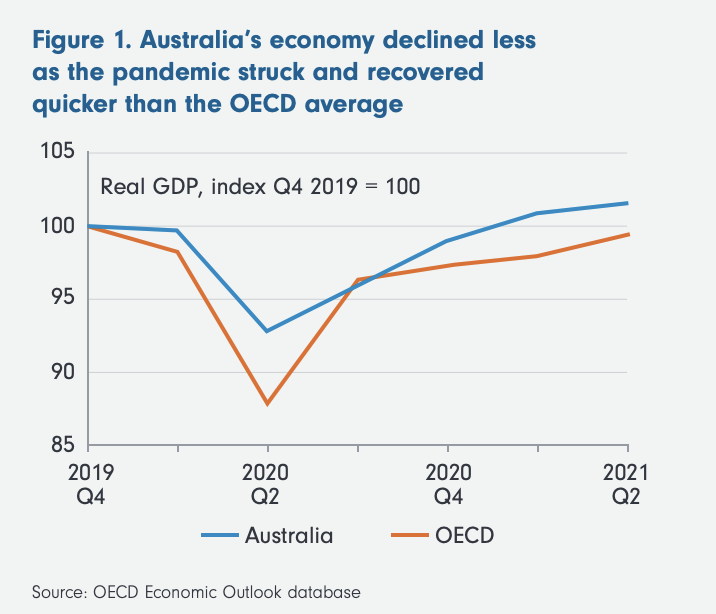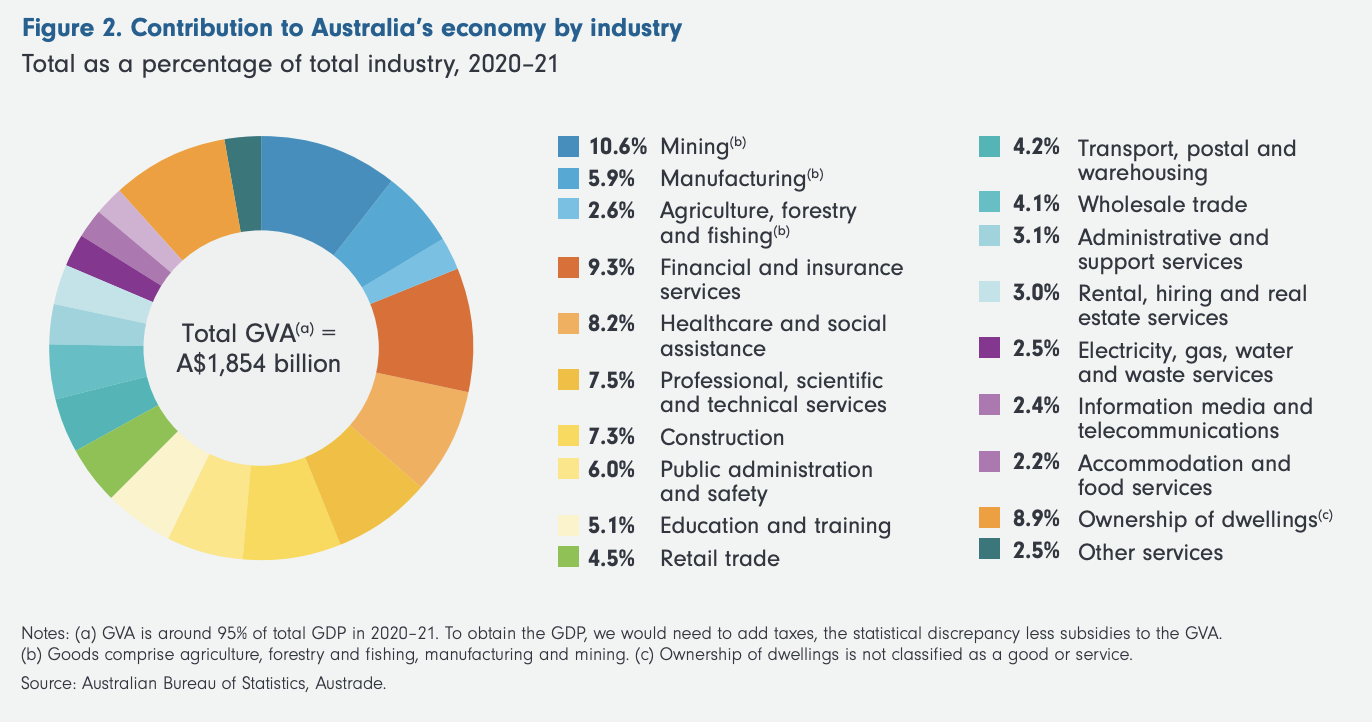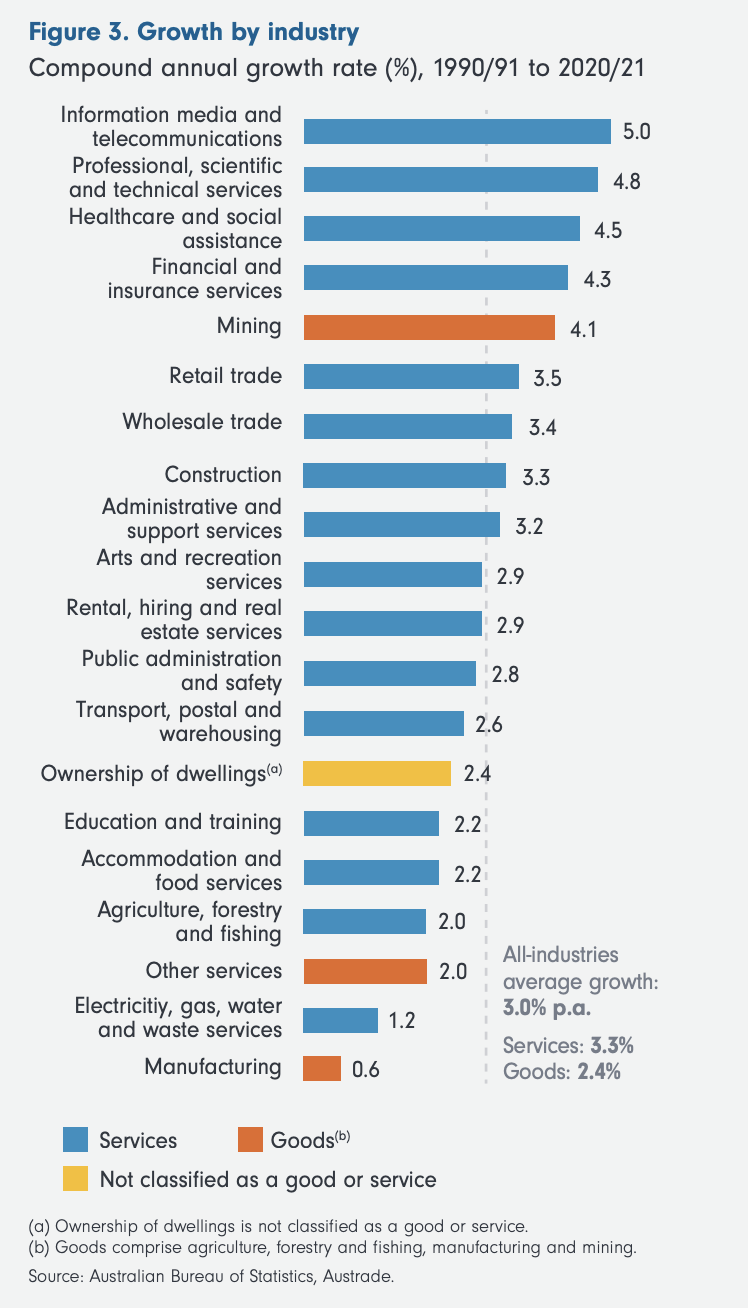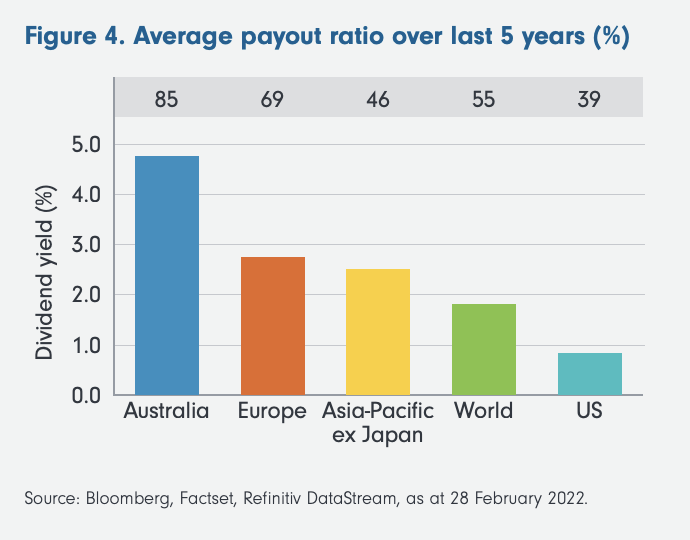The case for Australian equities

Updated May 2022
Blessed with resilience and resources
The Australian economy has proven more resilient than most during recent economic crises. It held up well in the face of the calamitous 1997 Asian financial crisis.1 It emerged relatively unscathed from the 2008–09 global financial crisis, thanks to its robust banking system and strong demand for resources from fast-growing countries like China.2 It dipped only briefly during the COVID-19 pandemic and experienced an earlier recovery than most OECD countries (see Figure 1).3
This resilience is underpinned by a diverse mix of industries.4 Not only does Australia have diverse and plentiful mineral and energy reserves, but its resources companies are considered leaders in technical and project delivery, and for their commitment to safety.5 The country’s leading financial institutions are also highly competitive within the Asia-Pacific region, with its fund management sector particularly recognised for innovation and sophistication.6

Several industries are flourishing
Financial services and mining, then, are vital to Australia’s economy, and they have performed strongly over the past three decades, recording compound annual growth rates of 4.3% and 4.1% in GVA terms respectively (see Figure 3).
Good though this is, three other industries outstripped even these economic stalwarts. The strongest performance was seen in information, media and telecommunications, which registered 5% compound annual growth in GVA from 1990/91 to 2020/21. Professional, scientific and technical services expanded 4.8% each year during that period, while healthcare and social assistance rose 4.5%. Opportunities, in other words, have been plentiful across a variety of Australian industries.


Although the COVID-19 pandemic temporarily slowed this momentum, earnings growth quickly returned in a variety of sectors including consumer, industrials, healthcare and financials. Real estate also rebounded quickly on the back of solid asset values.
The outlook for 2022 is positive: the overall economy is expected to grow strongly,7 with the rebound occurring alongside a wave of innovation that has the potential to create sustained gains.
Monetary policy should remain benign
There are some potential causes for concern, including mounting inflationary pressure from tight labour markets, elevated commodity prices and the rising cost of capital. On balance, however, the case for Australian equities remains compelling, and the country continues to be a preferred destination in which to invest, work and study. The reopening of borders toward the end of 2021 is expected to drive a rebound in travel after a period of stifled demand since March 2020.8 Companies are also expected to increase their investments.
And while inflation and the spectre of higher interest rates have increased uncertainty for Australian equities, we believe the market still offers structural, growth-led winners at attractive valuations.
A vibrant, consistently performing market
This bodes well for Australia’s vibrant equities market – the world’s ninth-largest, and which has consistently been among its best performers.
It’s worth noting that finance and materials have a disproportionately large representation on the country’s stock market, respectively holding a 27.8% and 24.4% weighting on the benchmark S&P/ASX 200 Index.9 Although the strong performance of these industries has contributed to the market’s consistent returns, their heavy weighting does create a degree of risk should their fortunes falter. It also means the benchmark index isn’t fully reflecting the relatively stronger growth seen recently in sectors such as technology and healthcare. Nonetheless, despite these issues, Australia’s stock market has delivered greater historic returns in US dollar terms than any other market since 1900.10
Over 2,000 companies are listed on the Australian Securities Exchange (ASX), the largest 200 of which are included in the S&P/ASX 200 Index, which represents over 80% of the market’s total capitalisation.11 Although other indices represent small-caps with valuations under A$2billion, mid-caps ranging from A$2–10billion and large-caps worth over A$10billion, the S&P/ASX 200 contains at least a few companies from each segment. The largest index constituents, BHP Group, Commonwealth Bank of Australia and CSL Limited, have valuations in excess of A$100billion. And the 20 biggest Australian stocks account for about 43% of total market value.12 The Australian small–mid-cap segment has been home to several future leaders that can generate considerable value for investors as they graduate to the larger cap arena. One such prominent recent example is the sleep apnoea equipment technology specialist ResMed, which was included in the S&P/ASX 50 Index in September 2021.
A greater focus on dividends
Australia has a well-established culture of dividend discipline, with dividends having contributed 53% of returns over the 121 years to 2021. By comparison, in the US, dividends accounted for 42% of returns over the same period.13
Given the importance of dividends in the local market, most of our actively managed funds focused on Australian equities are benchmarked against accumulation indices rather than those which measure only price change. Accumulation indices assume all dividends are reinvested and compounded, providing a better yardstick of total return derived from investing in the constituent stocks. For this reason, they are also known as total return indices. Australia’s dividend yield is one of the highest in the world, hence appeal from overseas due to the income angle.

Providing varied exposure
Fidelity has several Australia-focused funds offering varied exposure to local equities. The Fidelity Australian Equities Fund, launched in 2003 and benchmarked to the S&P/ASX 200 Accumulation Index, gives investors access to a diversified selection of 30 to 50 companies. It is designed as a long-term core holding and aims to outperform the benchmark over the medium-to long-term.
The Fidelity Australian Opportunities Fund, which is also benchmarked to the S&P/ASX 200 Accumulation Index, launched in 2012 and aims to provide capital growth as well as income potential over a long-term horizon. It offers access to a diversified selection of 40 to 70 companies, with the flexibility to take meaningful positions in the small- to mid-cap market.
The Fidelity Australian Low Volatility Equity Fund, benchmarked to the S&P/ASX 300 Accumulation Index, is a newer addition to the range, having been launched in October 2021. It is designed for investors who want a less volatile experience investing in Australian shares.
As well as applying disciplined analysis to stock selection, Fidelity’s various Australian equities fund portfolios are carefully weighted for diversification across sectors and companies. This further supports our goal of delivering sustained returns.
Why active management is key
Despite the lingering effects of the pandemic, Australia entered 2022 with healthy business and consumer confidence, which supports capital investment and high employment growth. The equity market is likely to remain strong, though characterised by increased volatility and dispersion of performance.
The benevolent market of 2021, with its forgiving valuations, generous risk tolerance, high liquidity and record-low capital costs will likely become more discerning and less euphoric.
These conditions call for an active investment approach, allowing capable portfolio managers to select the firms most likely to withstand market tumult while offering growth potential.
Paul Taylor has managed the Fidelity Australian Equities Fund from its launch and has been with Fidelity since 1997. Kate Howitt has headed the Fidelity Australian Opportunities Fund since the beginning and joined Fidelity in 2004.
With their wealth of experience, these proven portfolio managers are able to leverage the insights of one of the world’s largest research teams in making investment decisions.
Source: Fidelity International

